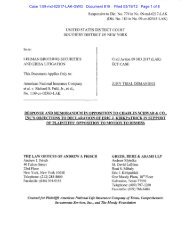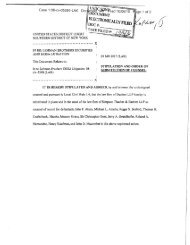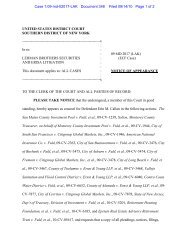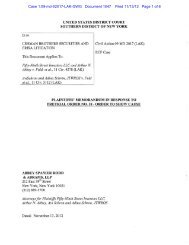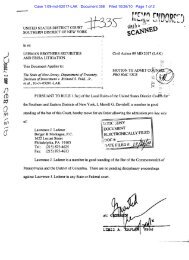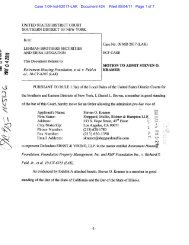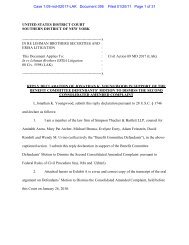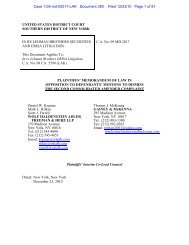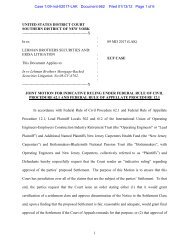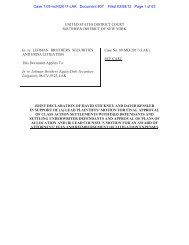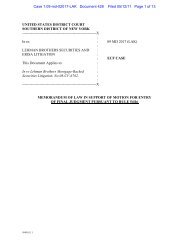part of financial statements and are read in conjunction with the notes to the financial statements.Here, <strong>Lehman</strong>’s accounting treatment for its Repo 105 transactions, and the total absence of anydisclosures about Repo 105 in footnotes, the MD&A section of the SEC filings or elsewhere createda false impression of <strong>Lehman</strong>’s business condition, violating GAAP. An analyst or a member of theinvesting public reading <strong>Lehman</strong>’s SEC filings from cover to cover, with unlimited time, would nothave learned about the Repo 105 program or <strong>Lehman</strong>’s true net leverage. To the contrary, <strong>Lehman</strong>affirmatively told readers that its repurchase agreements were treated as financial arrangements, notsales, under FAS 140.67. In addition, GAAP requires that financial statements place substance over form.FASCON 2, for example, states in relevant part:. . . The quality of reliability and, in particular, of representational faithfulness leavesno room for accounting representations that subordinate substance to form . . .(FASCON 2, 59)68. Additionally, AU § 411 states, in relevant part:Generally accepted accounting principles recognize the importance of reportingtransactions and events in accordance with their substance. (AU § 411.06)69. <strong>Lehman</strong>’s Repo 105 transactions lacked substance as “sales.” Whereas ordinary repotransactions provide financing but do not impact the balance sheet, <strong>Lehman</strong>’s Repo 105 transactionsdid. Elevating form over substance, <strong>Lehman</strong> engaged in tens of billions of Repo 105 transactions atthe end of its quarters for the purpose of improving the appearance of its balance sheet and netleverage ratio.2. The Offering Materials Misrepresented<strong>Lehman</strong>’s Risk Management Practices70. Throughout the Class Period, the Offering Materials included false and misleadingstatements concerning <strong>Lehman</strong>’s risk management, including, inter alia, statements about <strong>Lehman</strong>’sadherence to risk policies, compliance with risk limits, stress testing, risk appetite, and use of riskmitigants. <strong>Lehman</strong>’s statements were highly material to investors because, as an investment bank,risk management was critical to loss prevention. In particular, <strong>Lehman</strong>’s overriding of its risk-20-
management policies and systems enabled <strong>Lehman</strong> to amass billions of dollars of illiquid, riskyassets that it could not monetize to maintain its reported liquidity and net leverage ratio.71. Prior to 2006, <strong>Lehman</strong> focused primarily on the “moving business” – a businessstrategy of originating assets for securitization or syndication and distribution to others. In thisregard, <strong>Lehman</strong>’s wholly-owned subsidiaries, BNC, a California-based subprime mortgageoriginator, and Aurora, a leading Alt-A mortgage originator based in Colorado, originated subprimeand other non-prime mortgages for <strong>Lehman</strong>’s securitization business, which were then sold toinvestors.72. However, in 2006 and the outset of 2007, <strong>Lehman</strong>’s management began to pursue anaggressive growth strategy that caused the Company to assume significantly greater risk. Thisgrowth strategy depended on <strong>Lehman</strong>’s ability to increase substantially the leverage on its capital.As a result, <strong>Lehman</strong> shifted from the “moving business” to the “storage” business, making longerterminvestments using <strong>Lehman</strong>’s own balance sheet. This expansion strategy focused heavily onacquiring and holding commercial real estate, leveraged loans and private equity assets – areas thatentailed far greater risk and less liquidity than <strong>Lehman</strong>’s traditional lines of business. From 2007through the first quarter of 2008, as the real estate markets were collapsing, <strong>Lehman</strong> continued thisstrategy, which was considered “counter-cyclical” in that <strong>Lehman</strong> sought to acquire assets priced atthe bottom of the economic cycle. Thus, as other institutions reduced their risk exposure, <strong>Lehman</strong>increased its exposure to commercial and residential real estate.73. Although <strong>Lehman</strong> increased its net assets through this growth strategy (by almost$128 billion, or 48%, from the fourth quarter of 2006 through the first quarter of 2008), the marketwas unaware that the Company had become saddled with an enormous volume of illiquid assets thatit could not readily sell in a downturn. For example, BNC and Aurora continued to originatesubprime and other non-prime mortgages to a greater extent than other mortgage originators, manyof whom had gone out of business, that could not be securitized and sold off to investors, but ratherremained on <strong>Lehman</strong>’s books. At the same time, during the first two quarters of 2007, <strong>Lehman</strong>-21-
- Page 2 and 3: TABLE OF CONTENTSI. NATURE OF ACTIO
- Page 4 and 5: COUNT VI Violations Of Section 20A
- Page 6 and 7: CEO:CFO:CLO:CMBS:Commercial Portfol
- Page 8 and 9: SFAS 133:SFAS 140:SFAS 157:Financia
- Page 10 and 11: disclose that (i) it simultaneously
- Page 12 and 13: C. Defendants8. At all relevant tim
- Page 14 and 15: can only be ascertained through app
- Page 16 and 17: A. The Offering Materials Were Mate
- Page 18 and 19: 105 transactions, “[c]onsequently
- Page 20 and 21: Table 3 - Repo 105 Transactions and
- Page 22 and 23: financial condition and operations
- Page 24 and 25: were temporarily removed from Lehma
- Page 27: purpose to the transactions. Indeed
- Page 31 and 32: 76. Indeed, in order to engage in r
- Page 33 and 34: Lehman’s stress tests “meaningl
- Page 35 and 36: 3. The Offering Materials Contained
- Page 37 and 38: with regard to Level 3 inputs, SFAS
- Page 39 and 40: and other boom markets, focused on
- Page 41 and 42: specifically carved out “all [of
- Page 43 and 44: Lehman had already committed to fin
- Page 45 and 46: derivative component of the investm
- Page 47 and 48: generally accepted accounting princ
- Page 49 and 50: 119. After Lehman’s bankruptcy, i
- Page 51 and 52: misleading. The Securities Act Defe
- Page 53 and 54: 138. Plaintiffs and other members o
- Page 55 and 56: A. Repo 105 Transactions1. Lehman U
- Page 57 and 58: our governments businesses around t
- Page 59 and 60: 154. As the Examiner stated with re
- Page 61 and 62: 162. The Insider Defendants knew an
- Page 63 and 64: 169. Rather than disclose to the in
- Page 65 and 66: setting of risk limits.” These st
- Page 67 and 68: exceeded its risk appetite limits b
- Page 69 and 70: most part that are in-the-money”
- Page 71 and 72: y the Company on June 9, Callan sta
- Page 73 and 74: 198. The 2Q08 10-Q reported that th
- Page 75 and 76: cover lending positions. Jane Buyer
- Page 77 and 78: upon their conversation, McDade und
- Page 79 and 80:
(e) Lehman was motivated to manage
- Page 81 and 82:
c. On July 20, 2007, Nagioff emaile
- Page 83 and 84:
sell assets, and that the distresse
- Page 85 and 86:
accordance with the standards of th
- Page 87 and 88:
E&Y’s contemporaneous notes demon
- Page 89 and 90:
obligations when auditing and revie
- Page 91 and 92:
240. AU §§ 336 and 9336 address a
- Page 93 and 94:
A delinquencies and loss expectatio
- Page 95 and 96:
on behalf of Plaintiffs and other m
- Page 97 and 98:
involvement in the day-to-day opera
- Page 99:
(b)(c)(d)(e)(f)Awarding Plaintiffs
- Page 177 and 178:
APPENDIX ACOMMON STOCK/PREFERRED ST
- Page 179 and 180:
APPENDIX AISSUE DATEApril 4, 2008(t
- Page 181 and 182:
APPENDIX AISSUE DATEAugust 1, 2007A
- Page 183 and 184:
APPENDIX AISSUE DATEDecember 21,200
- Page 185 and 186:
APPENDIX AISSUE DATEFebruary 27,200
- Page 187 and 188:
APPENDIX AISSUE DATEMay 9, 2008May
- Page 189 and 190:
APPENDIX B
- Page 191 and 192:
APPENDIX BISSUE DATESECURITY(CUSIP)
- Page 193 and 194:
APPENDIX BISSUE DATESECURITY(CUSIP)
- Page 195 and 196:
APPENDIX BISSUE DATESECURITY(CUSIP)
- Page 197 and 198:
APPENDIX BISSUE DATESECURITY(CUSIP)
- Page 199 and 200:
APPENDIX BISSUE DATESECURITY(CUSIP)
- Page 201 and 202:
APPENDIX BISSUE DATESECURITY(CUSIP)
- Page 203 and 204:
APPENDIX BISSUE DATESECURITY(CUSIP)
- Page 205 and 206:
APPENDIX BISSUE DATESECURITY(CUSIP)
- Page 207 and 208:
APPENDIX BISSUE DATESECURITY(CUSIP)
- Page 209 and 210:
APPENDIX BISSUE DATESECURITY(CUSIP)
- Page 211 and 212:
APPENDIX C1. CW1, an underwriter in
- Page 213 and 214:
7. CW7 and CW8, investigators in Au



